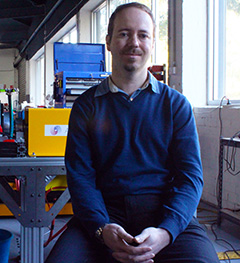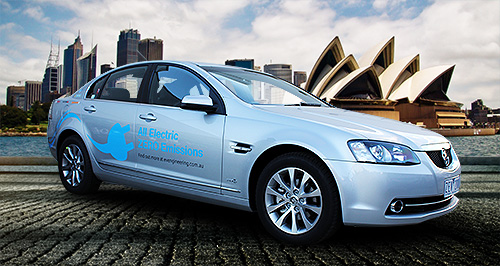Make / Model Search
News - General News - Manufacturing - AxifluxAustralia was ‘really close’ to Commodore EVSpark of light: Axiflux says the research carried out by former battery-powered Holden Commodore developer EV Engineering will live on if a viable commercial partner joins the project. New custodian of electric Commodore project carries on EV Engineering’s work13 May 2014 By BARRY PARK AUSTRALIA came within a hair’s breadth of having an electric version of the Holden Commodore on the market – priced for about $10,000 less than the cost of General Motors’ fully imported Volt – the company now behind the project has revealed. Melbourne-based electric motor development firm Axiflux has ended up with the assets from the not-for-profit EV Engineering after the last remaining joint-venture partners – Bosch Australia and Air International – pulled out in the wake of GM’s decision late last year to quit Australian manufacturing in 2017 and switch off the tap for the project’s donor car, the locally built Commodore. Axiflux chief technology officer David Jahshan has now revealed to GoAuto that at the time of GM’s decision, the project was close to securing funding for the next round of development, which was to commercialise the two years of work already put into the project and sell battery-powered Commodores for about $50,000 each. “EV Engineering got really, really close to actually having a product-ready device,” Mr Jahshan said. “And it’s really sad that the Australian car industry took a turn for the worst at that particular time. It all comes down to timing, doesn’t it?” According to Mr Jahshan, Axiflux joined the EV Engineering venture after work on the electric Commodore had finished, and as the project’s partners started talking about its next round of funding. He said Axiflux had approached EV Engineering about trialling its new in-hub motor that was capable of developing up to 1000Nm of torque, eventually joining as a partner early last year. “During that whole period we were just waiting for that next round to kick off, and the whole thing was being held in a holding position until the powers that be made a decision,” Mr Jahshan said. “And then it was decided it wouldn’t go ahead, at which point we put EV Engineering into a state where it was running but at a very low burn, basically as a skeleton where there was a search for future partnerships, but no active engineering development under the engineering umbrella. “Over the next few months, though, the members started dropping out – Futuris dropped out, Better Place disappeared, GE Finance as well, leaving just Bosch and Air International.  Left: Axiflux chief technology officer David Jahshan. Left: Axiflux chief technology officer David Jahshan.“After Holden made the announcement they pulled out as well, leaving Axiflux as the sole partner.” Even though the $3.6 million start-up assistance received under the former Labor federal government’s now-defunct Green Car Innovation Fund has dried up, Mr Jahshan said the fleet of seven electric Commodores that were created with the money were still in use, and would probably run until they failed. He said Bosch Australia had a couple of vehicles it was using, while another had been loaned to Melbourne University for a study that will dramatically enhance Axiflux’s understanding of how electric cars use, and abuse, their batteries. “One of the things I think is really missing is a comprehensive study of where the energy in an electric vehicle goes,” Mr Jahshan said. “One of the interesting things we saw in the Victorian EV trials was that the charging stations themselves drew a whole lot of energy in standby mode, which changed all the financial position, the pay-off time of an EV. “We found that when we charged in-house we’re getting 1:5 cost benefit whereas the Victorian government saw 1:3, and we’re just speculating but we’re wondering if the charge stations were taking up that extra percentage. “Having a really firm grasp of exactly where the energy goes inside an EV and how the batteries degrade over time is vital, so we’re doing a research project with Melbourne Uni over that,” he said. While work on the automotive side of Axiflux’s business has hit what Mr Jahshan said was “something of a slow burn”, he said the electric hub motor it has developed could reignite the spark if the right project came along. “In general, the feel for electric vehicles around the world has hit a null patch,” he said. “There’s a lot of discussion about it and now it has sort of petered off, but I think it is just taking a bit of a breather. “And I’d be surprised if it doesn’t have a slow increase because of all the positive factors that are involved with it. “If you have a look at Tesla with the range in their battery packs to make it more than an everyday drive. So there is a little bit of momentum building, and it will be interesting to see where things go from here.” Mr Jahshan said the big benefit to Axiflux to come out of the remnants of EV Engineering was the pace at which it could develop an EV platform if required. “In terms of the things that EV Engineering has, it has the technology to build battery packs, it has the ability to integrate systems, to integrate the battery with the motor and integrate it within a reasonable timeframe,” he said. “I think from go to product it was about a year and a half – so all the product knowledge is there for when a project that requires that sort of knowledge comes along.” However, finding that one big break would be more difficult without an Australian car industry, he said. “Where the biggest challenge is right now is that Australia is backing away from the automotive industry, and finding the right partner has just become a lot harder because there is no local partner,” Mr Jahshan said. “That’s a real challenge. It’s going to have to be a non-local conglomerate, so it’s not easy to find anyone local unless it’s a high-end sportscar … there are a couple of other high-end sportscars in Australia, but that is such a small market. “It needs to be financially viable for a development of that nature. “That said, there are enquiries and because we are able to do that integration work reasonably quickly, it could be attractive for an overseas producer to come here and get us to do their integration for them, and then do the production overseas.” In the meantime, Axiflux will concentrate on the industrial applications for its motor, which are likely to offer the best return on the time invested in development – which has received a big boost from the equipment set up by EV Engineering and now housed at Axiflux’s Southbank factory. “It was a huge boon for us blokes because, for example, what you saw out there, the test rig, the 200kW motor, if we were to build our own rig like that it would have cost us a couple of hundred thousand dollars,” Mr Jahshan said. “And we just happened to have that part on the shelf left over from EV Engineering. The same for the (Commodore’s removable) battery pack. “For a growing start-up, having access to equipment like that rather than basically having to pack up everything we want to test and take it to a test rig, and then come back with results with two months later – it just adds such a huge time cost and overhead. “Having these tools at our disposal has meant that we can accelerate our development, which has been fantastic. “So out of the whole system, EV Engineering has been huge win for Axiflux in terms of our ability to innovate, because we’re not spending all that time to reinvent the wheel, so to speak. “I can’t state how much of a fantastic outcome for Axiflux this has been. And EV Engineering is still there in the background, so if the right project comes along, EV Engineering would be the ‘vehicle’ that we do development under.” So was the groundwork laid down by EV Engineering worthwhile? “Absolutely,” Mr Jahshan said. “Will it result in the technology being rolled out to vehicles? I really hope so. “But again it all comes down to what commercially viable options there are to follow through with. “If the right opportunity does arise, then absolutely.”  Read more |
Click to shareGeneral News articlesResearch General News Motor industry news |












Facebook Twitter Instagram